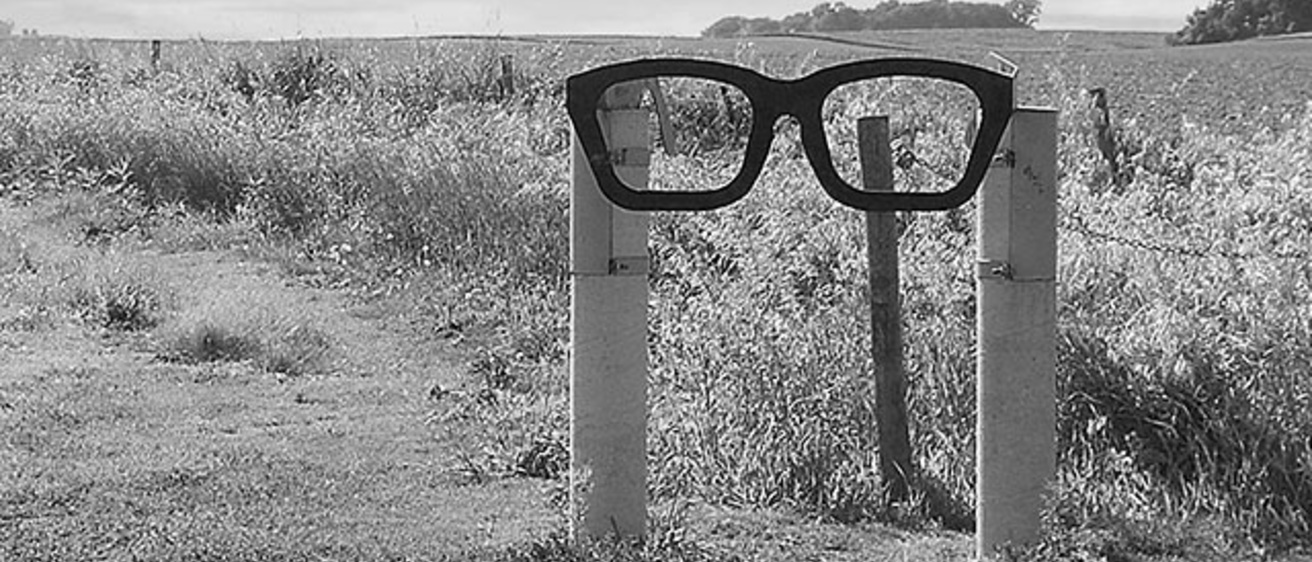Editor's note: The University of Iowa offers lots to do throughout the year, from arts performances to readings, and lectures to recreation. But sometimes faculty, staff, and students want to explore areas beyond campus. So University Communication and Marketing is publishing a series of "daytripper" stories this summer, pointing to fun, interesting, and uniquely Midwestern destinations within a day's drive of Iowa City. This story is the third story in the series, which can be found here.
NORTH OF CLEAR LAKE—This is a strange place for the music to die, a farm field in the middle of Iowa that looks like most any farm field in Iowa, except this field happened to claim the life of one of the most influential American musicians of the 20thcentury.
The story is well known to most everyone alive at the time—or who wasn’t but heard American Pie or saw La Bamba. Following the Winter Dance Party’s Feb. 2, 1959 performance at the Surf Ballroom in Clear Lake, Buddy Holly loaded into a plane with Ritchie Valens and J.P. “The Big Bopper” Richardson bound for their next concert in Fargo.
But it was February in Iowa and it was cold and snowy and the pilot was inexperienced and the plane crashed in a farm field five miles north of the Mason City Airport, killing all four on board.
It is Iowa’s most immediate connection to rock and roll history—the state never having produced an enduring, widely popular act of its own, at least on a national scale—and so the tragedy is duly memorialized.
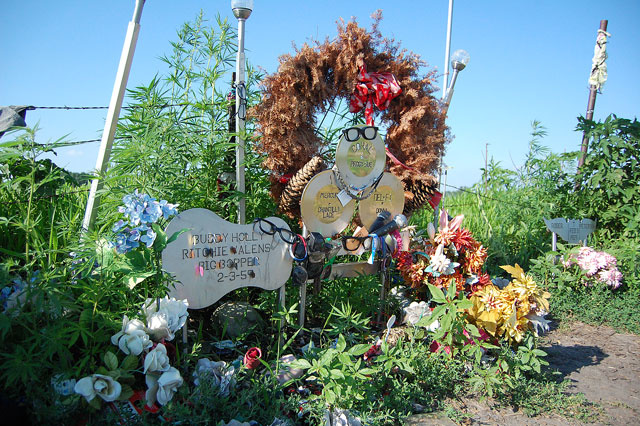
Drive north from Clear Lake five miles, pull over on the side of Buddy Holly Place and tromp a half mile through the fields and you’ll find a guitar-shaped piece of steel engraved with the names of the deceased and the date of their deaths: 2-3-59. A fan who was handy with a metal cutter donated it to the farmer who owns the land and it’s been planted at the spot of the crash since the 1980s.
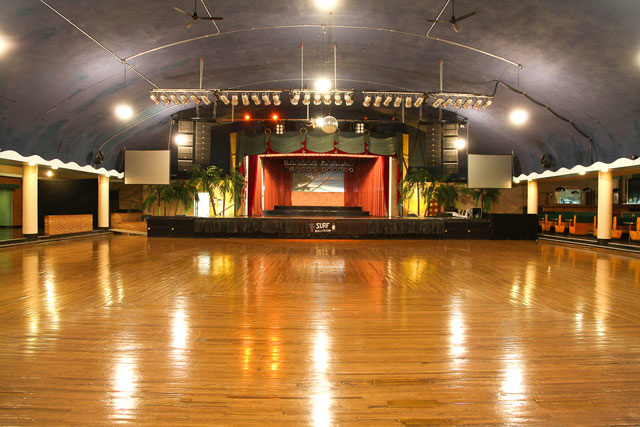
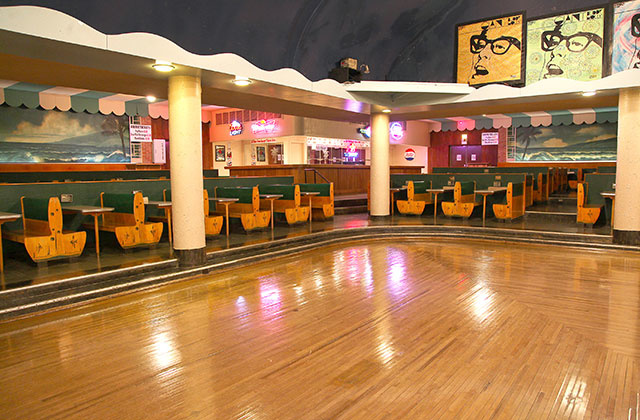
And back in town, the Surf itself is still in business, recognized on the National Register of Historic Places as one of the last of the old-style ballrooms left in the Midwest. It’s struggled through the years—it’s been opened and closed often and only a last minute reprieve saved it from the wrecking ball in 1972—but it’s found stability after converting to a nonprofit operation. It’s restored now to its 1959 look and books musical acts as diverse as Little Big Town, BB King, and Ratt. It has its own memorial to that tragic night, and a small museum dedicated to Holly and other luminaries who played there over the decades.
Of course, none of this is on the order of Elvis’ Graceland or Jim Morrison’s grave in Paris, which draw crowds from around the world. Holly never rose to the career heights of Elvis or the Doors or many other acts. He was only 22 when he died and his three-year commercial musical career was impressive but short—three albums, eight Top 40 Billboard singles, and one Number 1, "That'll be the Day."
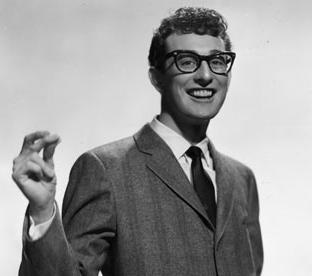
Not much for the public to remember, certainly nothing compared to Elvis, who by then was firmly established as The King, but who would soon throw away his rock and roll image with a stint in the Army and bad movies. Rock was also losing its popular hold to the folk stylings of acts like Joan Baez, the New Christy Minstrels, and Peter, Paul, and Mary. There were also the Southern California sounds of the Beach Boys, and Motown was creating a whole new style of R&B that further pushed rock and roll to the margins. So while Holly’s death was above-the-fold news at the time and set off a national wave of teenage grief, the culture was changing so rapidly it wasn’t long before he became "that guy with the glasses who did 'That’ll be the Day.'"
While Buddy Holly was the icon, he was not the only significant musical figure to die that day in Clear Lake. Steve Horowitz, an adjunct professor of American Studies, says Ritchie Valens represented the Latin influence on contemporary pop and had his own Number 1 hit with “La Bamba.”
“Latin rock was an important part of early rock and roll, especially the music coming out of Southern California, but we’ve forgotten that,” he says. “Ritchie was the most successful of those acts. He wasn’t the musician that Holly was, and his aspect of the music was written out, but he was a significant player.”
As for the Big Bopper, he was a DJ and budding pop and country songwriter who had already written two number 1 hits, including “White Lightning” for George Jones and his own career-definer, “Chantilly Lace.”Though as a recording artist, his career never had the chance to advance much further than a novelty act.
But among musicians, especially those in England, Holly’s music was something to be pored over and studied and covered and emulated and generally adored. John Lennon and George Harrison learned to play guitar using Holly’s songs. Mick Jagger and Keith Richards bonded while listening to his records. A 16-year old Bob Dylan was profoundly affected seeing Holly play the Winter Dance Party’s show in Duluth, Minn., two nights before the final Clear Lake performance (of course, that must be taken with a grain of salt, given Dylan’s history of amorphous autobiographies, but at least it’s plausible).
This reverence would eventually make its way to their records, says Donna Parsons, UI lecturer in music and honors. The Rolling Stones covered "Not Fade Away" on their first album. Dylan went electric. The very first track the Beatles ever recorded—as the Quarrymen—was a promotional single of “That’ll Be The Day,” and Holly’s “Words of Love” was on their album Beatles For Sale. Even their name was a variation of the Beetles, in honor of Holly’s band, the Crickets.
“If you listen to ‘That’ll be the Day,’ Lennon sings as if he’s trying to consciously imitate Holly’s Texas twang,” Parsons says.
And it’s strange to associate Dylan, the Beatles, and the Stones with a farm field in Iowa.
Holly changed the game of rock and roll in an age when rock and roll was driven by managers and producers and Brill Building songwriters, not all of them playing the game legally or ethically. Holly wrote his own songs, played his own guitar, sang his own lyrics, and produced or co-produced his own records. The Crickets established the model for a rock and roll band for years to come—lead guitar, rhythm guitar, bass, and drum.
He stretched himself musically, tried unusual vocal phrasing (“alla my love, alla my kisses, you don’t know what you been a-missin’”), experimented in the studio with multi-tracking, overdubbing, and double miking. In his final days, he was sampling with more straight country songs, and even experimenting with an orchestra. Listen to his odd version of Real Wild Child and it still sounds weird, more than 50 years after it was recorded.
“His music doesn’t sound dated,” Parsons says. “There’s a rawness and an electricity to his songs that still resonates today.”
All of this belies his public image, then and now, of a skinny, well-dressed nerd with tousled hair and thick glasses. Steven Horowitz, adjunct associate professor of American Studies, says Holly was marketed as a mild-mannered, mid-American white kid, Dick Clark safe.
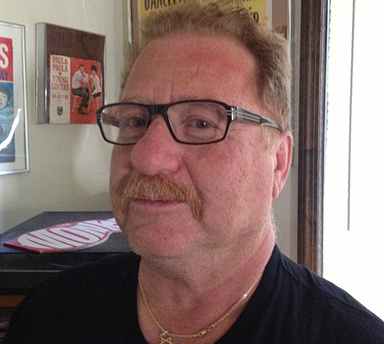
“But he wasn’t safe, he was a pioneer,” says Horowitz. “He combined black and white music and played songs that were obviously black, that were dirty and raunchy. He understood that rock and roll was dirty, that it was sexualized. He knew its roots.”
When the Crickets played the Apollo, the audience wasn’t sure what to make of him, wondering who this white kid was thinking he could play black music. But Holly’s slinky voice and scintillating guitar work won them over.
“His musical influence is probably bigger than Elvis’,” says Horowitz. “As a rock star, he’s not in the same league, but as a musician and musical pioneer, he has a much stronger legacy. Listen to Keith Richards and it’s obvious he listened to a lot of Buddy Holly.”
But the timing of his death meant he would almost fade away himself, despite the enormous influence he had on so many of the musicians who would bring rock and roll back in the 1960s. Even in Clear Lake and Mason City, the area’s link to pop culture history became only a piece of background noise, at best a curiosity, at worst a source of shame.
“There was a sadness that this happened here, and none of the families ever came to visit after that, we never saw them,” says Connie Mueller, curator of the Iowa Rock and Roll Museum and Hall of Fame in Arnolds Park. “It was something that people wanted to forget.”
Eventually, though, American audiences rediscovered Holly thanks to Don McLean—a folky type, of all people—and his iconic hit, American Pie,a cryptic, metaphor-filled allegory that traced all the bad stuff happening in America back to the February day that made him shiver. Since then, Holly has reclaimed a shelf in the American pop culture library.
Oh, Boy, Rave On,and the Diddley-ish Not Fade Awayare instantly recognizable sublime classics. Gary Busey was nominated for an Oscar for playing Holly in a 1978 biopic. The 1984 movie Peggy Sue Got Married was based on Holly’s song of the same name, and the band Weezer started its career with a song called Buddy Holly.Rockabilly revivalist Marshall Crenshaw played Holly as a supporting player in the Ritchie Valens’ biopic La Bamba in 1988, featuring Los Lobos' rousing cover version of the title song.
And Clear Lake and Mason City have embraced him, too. Mueller said the mood started to change in 1988, when the Surf dedicated its memorial and invited the victims’ families, several of whom attended, including Holly’s widow, Maria. More than that, the memorial included the name of Roger Peterson, the local man who flew the doomed flight.
“It brought closure,” says Mueller. “It brought the families together and there were hugs and tears. It brought closure.”
Now there’s Buddy Holly Place, and visits from fans making pilgrimages, including a group from a Buddy Holly fan club in England that visits every year. The Winter Dance Party is back, too, performed every Feb. 2 in the 1959-vintage Surf Ballroom.
“It’s amazing because when I’m there, I’m seeing exactly what the kids saw that night on Feb. 2, 1959,” says Mueller. “It’s just beautiful.
And then there is the cornfield memorial, decorated with mementos left by people touched by Holly and the others—flowers, models of ‘57 Chevys, toy guitars, handwritten messages, LPs and 45s, lots and lots of black-rimmed glasses. It’s sentimental and maudlin, but yet, there is something haunting about it, a sense you don’t get at other iconic pieces of property associated with tragically dead rock stars. Parsons thinks it’s because this is the field where Holly actually lay in his final moments—along with Valens and Richardson—right there, on the ground. Walk around and you will inevitably tread on the exact spot where they died.
“I know this sounds macabre, but Buddy Holly's DNA is in that ground, their spirits are there,” she says. “We don't have a studio, unlike Motown's Hitsville U.S.A. in Detroit. We don’t have a home to visit, like Graceland. We don't have anything tangible for Buddy Holly.”
But we do have this farm field in Iowa.
